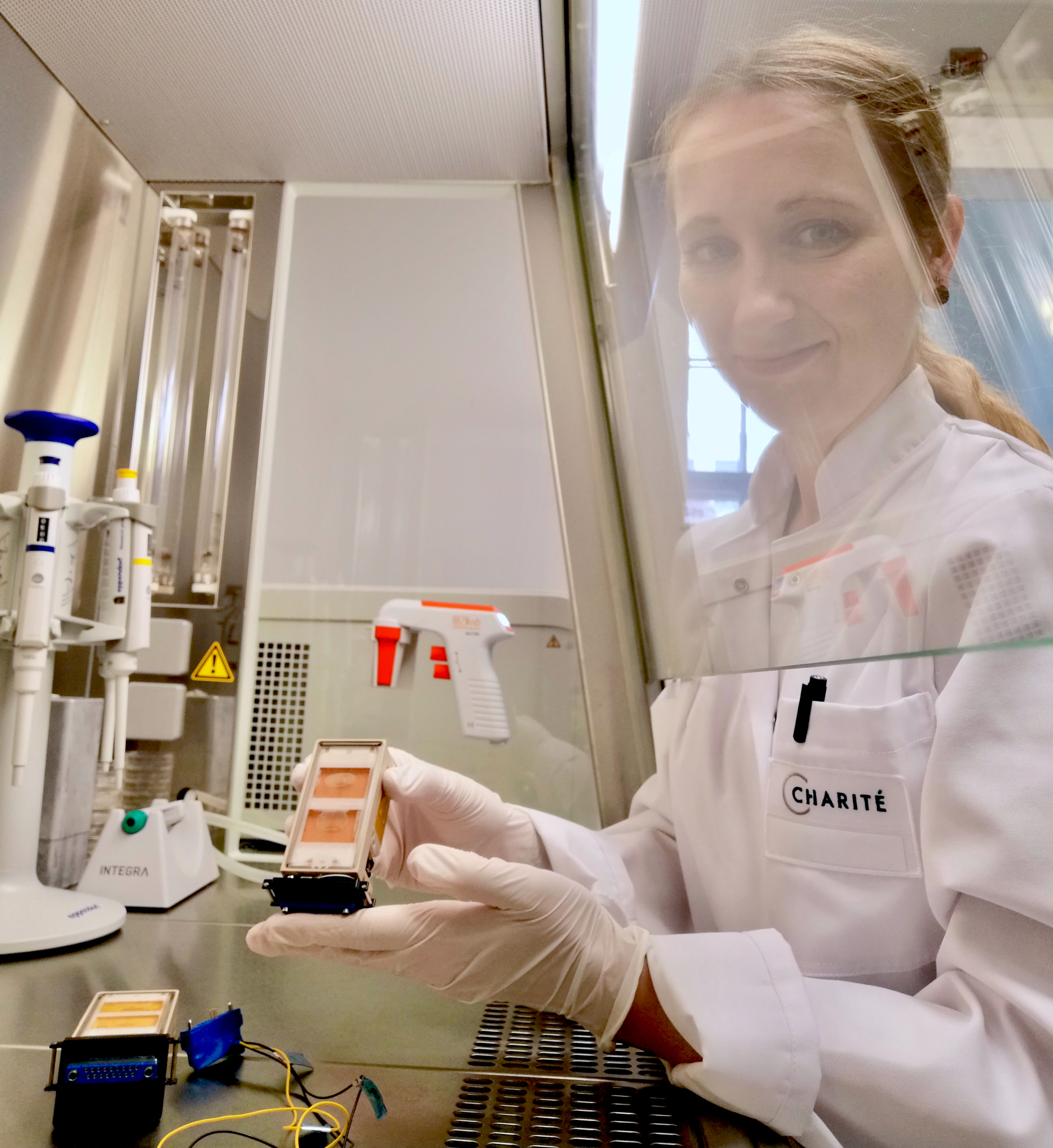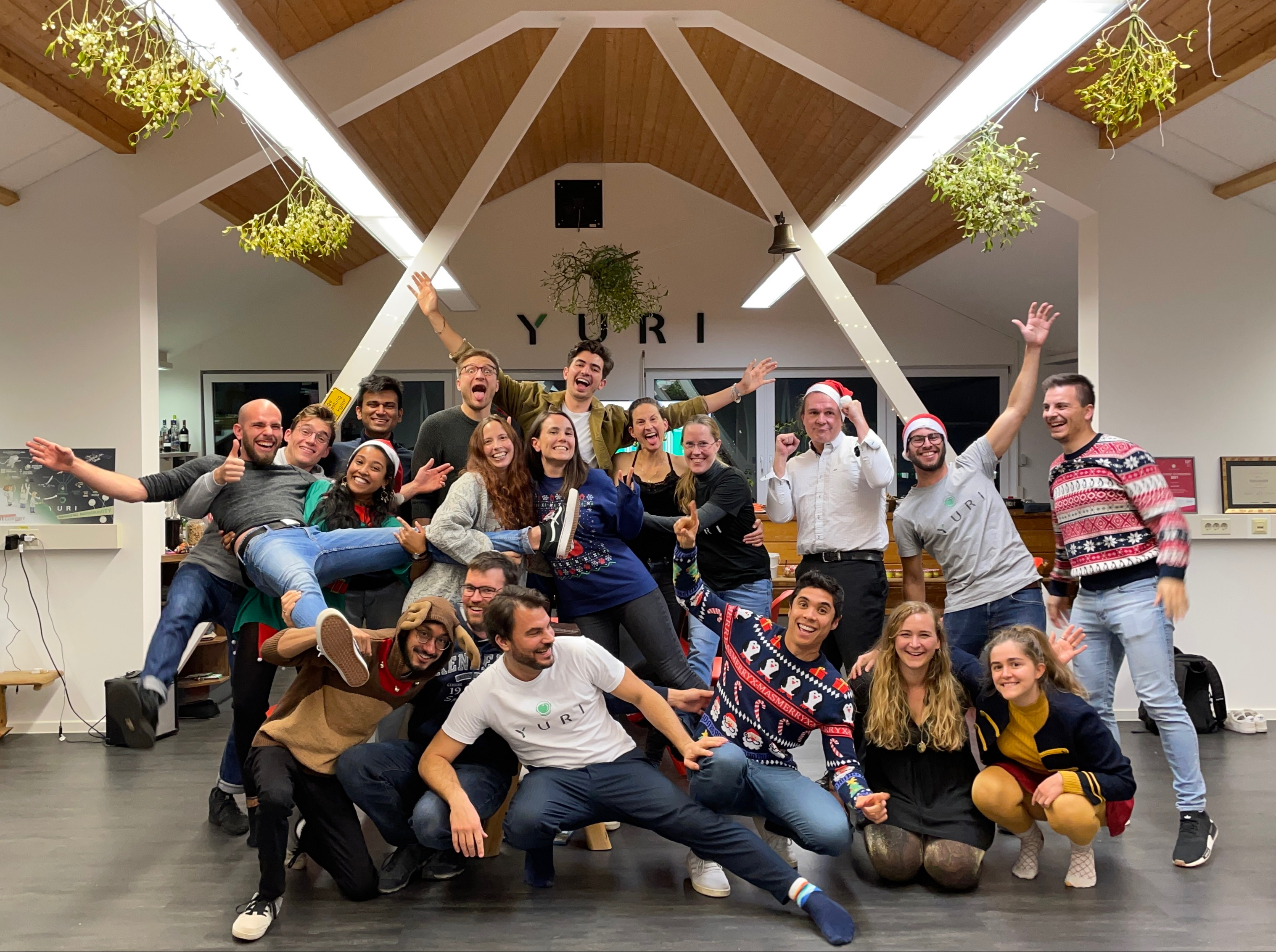Biotech in outer space
yuri, a space start-up: weightlessness for commercial research
Growing cells without the effect of gravity could revolutionise drug development. A start-up called yuri on Lake Constance enables made-to-measure experiments on the ISS for stem cells, artificial organs, surfaces and materials. On board the next mission are some mini-cell labs from Berlin's Charité and Goethe University Frankfurt.
The mini-labs of the Meckenbeuren-based start-up yuri consist of ten cubic centimetre boxes filled with human cells in a nutrient solution – and they are being installed on the International Space Station at an altitude of 400 km. The boxes hold secrets that the researchers would like to unlock immediately. However, patience is required: the experiments that leave the ground in August will be carried out fully automatically in space – and returned to Earth after a six-month mission to be analysed in the research institutes. This is unusually fast for microgravity experiments. And we are not referring to the speed of 28,000 km/h at which the ISS orbits the Earth.
Into space and back - Charité and Goethe University Frankfurt in the box
"Experiments in weightlessness can provide new insights for medicine, physics and the life sciences," explains Mark Kugel. "Until now, however, experiments on the ISS have been difficult, expensive and very time-consuming." Kugel is one of the four founders of yuri, along with space engineer Maria Birlem and engineers Christian Bruderrek and Philipp Schulien - all of whom have previously worked with Airbus and NASA. "Until now, the market was only open to space companies," chief commercial officer Kugel continues. "With yuri, we are making it possible for any research institution to carry out projects on the ISS."
By pooling several experiments in one mission, with its expertise in special hardware and by reducing experiment time to six months, yuri can significantly reduce costs: an ISS research mission will now be priced at less than 100,000 euros instead of the one million euros it previously cost. The space service provider is a one-stop shop that prepares the modular experiment box and manages all the formalities and people up to the flight and expedition. There is a steep upward trend towards microgravity experiments, especially in the biotech sector: the Berlin Charité and Goethe University Frankfurt are currently taking advantage of yuri's commercial offer to gain scientific insights under weightlessness. Both projects are listed with NASA1).
Immune system and artificial organs under weightlessness
The SHAPE1) (Spheroid Aggregation and Viability in Space) project, under the scientific direction of Dr. Francesco Pampaloni from Goethe University Frankfurt, aims to gain a better understanding of how microgravity affects the human immune system at the cellular level. The idea behind it? The findings could be significant for future long-term stays in space. It is known that the immune system is weakened under almost no gravity and can only fight off potential infections with difficulty.
But there is much more at stake: the findings can serve as a basis for future therapy developments for infectious or immune system diseases. What processes cause ageing bone marrow to weaken the immune system? To what extent does the activity of immune system genes change?
 Scientist at the Charité with the cell culture research chambers. The cells in the chamber are supplied with nutrient solution by an integrated pump and attached tanks. © yuri GmbH
Scientist at the Charité with the cell culture research chambers. The cells in the chamber are supplied with nutrient solution by an integrated pump and attached tanks. © yuri GmbHTo carry out their experiments, the research team is sending stem cells to the ISS in fully automated microlab boxes provided by yuri. Two types of cells were prepared in hydroxyapatite, a main component of bone. Spheroids, i.e. three-dimensional cell aggregates (such as known from human bone marrow), only form in a microgravity environment, and their formation cannot be reproduced stably in laboratory settings on Earth. The reason for this is that cells and proteins are unstable and decompose too quickly to be analysed in their natural network. However, in a situation where gravity and centrifugal force almost cancel each other out as a result of orbital motion and where there are no deposits or convections, three-dimensional cellular tissues are possible. How do they form? What is the viability and spatial separation of the different cell types within the multi-layered structure of the spheroids?
The samples will provide this information when they are analysed using 3D light-sheet microscopy after returning to Earth. Gene expression will also be determined. Precise and detailed knowledge of the spatial structure and the genes involved will help to better understand functions and properties in order to develop pharmaceutical applications. Kugel sees further potential here: "Since body cells under microgravity grow like real body tissues, it will be possible to create improved artificial tissues as well as organs in space." They could be used in transplant or precision medicine, where artificially produced autologous tissue could be used to determine the optimal combination of active substances for each individual. In addition, tissues grown in space could reduce the number of animal experiments.
Growing muscle cells
After just one to two weeks in space, muscle mass begins to degenerate, as it does not bear any body load in a gravity-free state. "It is important to understand in detail how muscle degeneration occurs. In this way, we can identify parallels in people suffering from muscle atrophy," says Kugel. This is where the Institute for Integrative Neuroanatomy at the Berlin Charité comes into play. In the NEMUCO1) (Nerve-Muscle Co-culture) project, the team led by Dr. Michele Salanova is investigating which factors play a role in the demineralisation of the bones and the sensitivity disturbance of certain nerve endings.
 The yuri GmbH team at the Meckenbeuren headquarters © yuri GmbH
The yuri GmbH team at the Meckenbeuren headquarters © yuri GmbHHere, too, the researchers hope to gain deep ‘out of the box’ insights: for this purpose, isolated nerve cells are cultivated together with young muscle cells and sent to the ISS in cell boxes. While still in weightlessness, the 3D structure of the cells is fixed and the samples are analysed at the Charité after their return. RNA sequencing and analyses of all proteins in the cells are expected to provide information about the molecules and signalling pathways involved in the interaction between nerve and muscle cells.
The idea is to discover relationships that lead to a deterioration in the structure and function of neuromuscular junctions, which affects muscle control and fine motor skills. This is a potential milestone for developing new therapies to build healthy muscle tissue, given that autoimmune diseases, myo- and polyneuropathies, ageing processes or prolonged bed rest lead to the same deterioration in musculature as time spent in space.
Biotech pioneer in space
Before an experiment finds its way into the science box to be sent into space, a few steps have to be carried out on the ground, as Kugel explains: "We carry out a feasibility analysis with the research teams where our previous findings with 3D tissue models can prove valuable for future experiments in drug screening, toxicity or the development of healthy tissue." To ensure that the preparation of the samples succeeds in the narrow time window available before the rocket launch, researchers practise the procedures under real conditions. The tricky part is that there must be no air bubbles trapped in the cell cultures or caused by sealing problems, otherwise the cells will die. On launch day, the experiments are placed in the boxes, installed in an ISS incubator, and will during the trip undergo automatic media changes and fixation according to a predefined schedule before they are stored at 4 °C until further analysis.
Looking at how the Lake Constance start-up has developed since its foundation in 2019, it’s clear that yuri has got off to a flying start. The countless awards the company has received confirm its potential, enabling it to grow into a team of 30 at its locations in Meckenbeuren and Luxembourg. Their objective is clear: yuri wants to become a space biotech company and thus a driver of innovations: stress and brain research, research into neurodegenerative, immune and infectious diseases and the development of tumours, material sciences and microelectronics for medical technology - the horizon is endless. We look forward to seeing what yuri will come up with next.